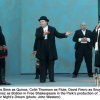San Francisco Shakespeare Hits It with a Lusty Dream
Hot- Midsummer Night's Dream
- by William Shakespeare
- San Francisco Shakespeare Festival
- September 1 - 23, 2007
| Acting |  |
| Costumes |  |
| Sets |  |
| Overall |  |
At the end of A Midsummer Night’s Dream, Puck wants us to perhaps consider the play “no more yielding but a dream.” Director Kenneth Kelleher, on the other hand, gives us a play that is just that. The initial stage carries a framing tale, of sorts, with a separate foot and headboard center stage between which Theseus and Hippolyta fall asleep. Once asleep, the foot and headboard part to far stage left and right, signifying that what happens next, and until the Duke and his reluctant bride awake the following day, is, indeed, one fantastic dream.
Kelleher’s production has certainly made its rounds. Since the end of June, they’ve traveled from Pleasanton to Cupertino to San Mateo, and finally home to San Francisco, where any “rough spots” have been smoothed, and any “hodgepodge” sorted out. They are also welcomed home by a loyal and smart San Francisco audience, filled with patrons who seem to comprehend every analogy, every play on words, and every single delectably dirty pun, no matter how obscure.
Music plays a fair part in this production, running a thematic gamut with “Narcolepsy” (Ben Folds Five), “Wrap Your Troubles in Dreams” (Velvet Underground), Titania’s lip-synced substitution for her Ovidian lullaby “Let’s Dream in the Moonlight” (Billie Holiday), a cleaned up version of Ludacris’ “Go to Sleep,” Dandy Warhol’s sensually-staged “Sleep,” a rendition of Cole Porter’s “What is this Thing Called Love?” and a guest appearance by the parrots of Telegraph Hill. San Francisco’s wind engages in a bit of foul play, revealing trap doors and blowing turf right into the hands of Demetrius, but John Sousa ad-libs a bit, and the audience is more than forgiving with their hands.
There are four discordant storylines in Midsummer—Theseus and Hippolyta; the lovers; the mechanicals; and the fairies— that must somehow come together in order to achieve the inevitable concord of a Shakespearean comedy. Fair Juliet may call the moon inconstant, but in this play, it is the one constant that unites these four stories. This conceit is prevalent throughout the play, with the word “moon” raised in various ways some twenty-eight times. Kelleher incorporates this conceit, as well as his own version of the moon—a large, white medicine ball—in a clever way, guiding everyone through their own phases and transformations, and leading all toward a conclusion of enlightenment.
And like most dreams, this one is both beautiful and bizarre. Michael C. Storm plays Theseus as a staunch, misogynistic Duke who looks as though he marched out of Stalin’s army rather than the ancient Greek battlefield; and Hippolyta, played by Emily Jordan, is a conquest and a captive, more charmed by the moon than by her fiancée’s harsh demeanor. But once asleep, the two “awake” and tear off their overcoats in revolution, transforming into a skintight-clad fairy King and Queen who look like they stepped straight out of “Barbarella.” Puck (played by Rowan Brooks, who also doubles as the alarm clock-carrying Philostrate) and all the fairies may very well have missed the art-car to Burning Man. Brooks sports a pair of goggles and shows off a tight little pack of six through an open yellow vest as he lusts after Titiania’s fairies, who strut and tease over hill and dale wearing their own goggles, as well as red lace petticoats and platinum wigs. Storm and Brooks are a great team. Storm’s Oberon is comparable to a Greek god who is perhaps a bit bored and chooses to play with both mortals and not for the sake of sport, ending each sinister plot with a goofy laugh. Brooks carries out these plots with fabulous British diction, great energy and excitement, and the two together are so very pleased with themselves. When not running errands for Oberon, Brooks is busy stealing clothing and trinkets from anyone he happens upon. Fairies Cobweb, Peaseblossom, Mustardseed and Moth are grotesque and colorful versions of various creatures (a goat, a dog, a rooster, and a praying mantis is my guess) and are, if nothing else, a visually unsettling part of this dream.
Our mechanicals are vaudevillian in nature—wearing black suits with whitened faces—and perform a perfectly over-the-top version of “Pyramus and Thisbe” that will leave your belly aching from laughter. Gary S. Martinez is spectacular, playing the know-it-all Bottom with a lot of character and a lot of panache. With every movement, Martinez strikes a pose; every pose delivers theatrics, and his theatrics generate loads of laughs. His big reveal in donkey garb is somewhat anticlimactic, but the show soon reaches its peak again as the Fairy Queen falls in mad love with an ass, straddling him and proceeding to tame her lover with a riding crop. This is all well-met by Martinez’s submissive “hee-haw!” The sideshow or animal act of this vaudeville show is represented by David Fierro who delivers a disturbing version of Snug the Joiner. Fierro plays a simpleton who wears a rope leash around his rotundly-postured belly, which is either held by Snout (Mick Mize), or tied to something offstage. On the one hand, Fierro is sweet and endearing to the point of engaging (or forcing) Theseus into a hug after his portrayal of Lion. On the other hand, one must question why this man with a rubber face of expressions must at all times be on a thick rope leash.
Helena and Hermia, played by Maria Grazia Affinito and Summer Serafin, respectively, enter the play like night and day. Affinito also looks as though she may hitch a ride to Black Rock with the fairies, wearing a black lace petticoat, black hoodie, moon boots and glasses (not goggles). The poor dear is angry and seems bipolar and without her meds, but when not riding her roller-coaster of emotions, Affinito is engaging in soliloquy and an equal comedic rival for Hermia. Serafin plays Hermia as a manipulative, pretty little princess who moves like a dancer upon the stage and speaks in a baby voice to get what she wants. Serafin resorts to violence and her prim demeanor turns fierce once things in the play stop going her way, leading her to stand on point every time Affinito calls her “little.” The objects of their affection, Demetrius (Sousa) and Lysander (Nicholas Pelczar) are appropriately interchangeable in demeanor, but in appearance, Sousa is every parent’s dream, while Pelczar presents himself in a “Public Enemy” T-shirt, a flannel wrapped ‘round his waist, and a yellow ski-cap (the latter of which is lifted by the thieving Puck).
The end of this Dream is deliciously confusing and jumbled like many dreams are just before you awake. What seemed so clear before is now cloudy and hazy, whereupon waking, it is sometimes difficult to gauge what is real and what is not. Theseus and Hippolyta and their sweet friends are to bed after making a collective moan over the mechanical’s wondrous strange show, but the Duke and his new Duchess awake, again transformed into fairies. Philostrate transforms into Puck to sweep the stage. The moon, which begins in the hands of Philostrate, remains constant as it lands in the hands of Puck, permitting Brooks to begin and end the show full circle.
Discuss this review or play in our forums
Reviews on this site are subject to this required disclosure.











